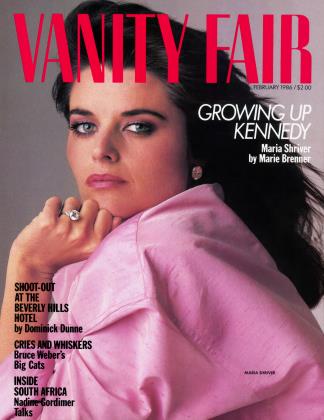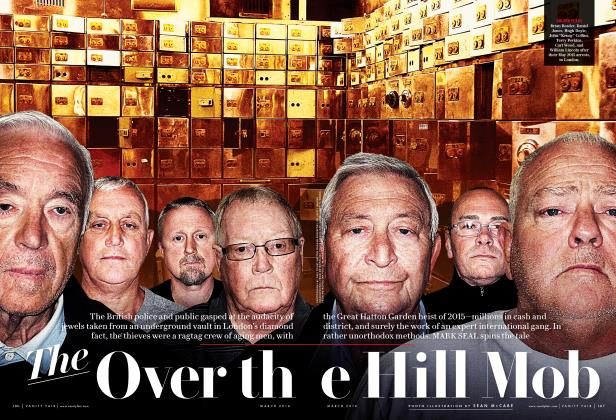Sign In to Your Account
Subscribers have complete access to the archive.
Sign In Not a Subscriber?Join NowOut to Lunch
with Parisian designer Sonia Rykiel, who orders fresh raspberries but samples JAMES DANZIGER's chocolate cake
Five days have passed since the highly successful showing of Sonia Rykiel's spring '86 collection. Last night Mme. Rykiel won a special Oscar (you now get them for fashion in France) in a glittering ceremony at the Paris Opera. Thus, at lunch today, her press agent has confided, she is likely to be, quite frankly, exhausted.
We are to meet at Le Recamier, a favorite haunt of Mme. Rykiel's that can be found in a little cul-de-sac off the Rue de Sevres. The restaurant is quiet, peaceful. Sun filters in, lighting up the dark velvet interior and making one feel immediately at ease. Sonia Rykiel arrives—without makeup, wearing dark glasses, and dressed in a black swan-feather coat which she leaves on throughout the meal. With her flaming-red hair and pale, translucent skin, she gives the impression of a Technicolor animated sphinx.
I ask her why she is so fond of Le Recamier. "It is,'' she says, as though responding to a Rorschach test, "sophisticated, but at the same time simple. Traditional, classic, but at the same time with things a little funny, un peu baroque."
Mme. Rykiel chooses two appetizers, celeri remoulade and a grapefruit cocktail, followed by fish—escalope de bar grille au gratin de courgettes. I ask our waiter about the Salade Paul et Virginie, which turns out to be a simple, but colorful, mixed salad. The headwaiter recommends the boeuf bourguignon aux tagliatelles fraiches to follow. Sonia does not want wine—only a little water.
Unlike most fashion designers, Sonia Rykiel came to the profession by accident. Her earliest memories of clothes are not of dreaming about elegant outfits but of threatening to walk out of the house naked after her mother had thrown away her favorite sweater. "It wasn't that I loved the sweater so much, but I intensely didn't want to grow up. A lot later, my ambition was to have ten children, to get married, to take care of the house. Then I married a man who had a shop, so I had his people make some dresses and some knits for me, and when I wear them everyone want that. So I put them in the shop, and the first pullover I make become the cover of Elle magazine. It was like I had gold in my hand. I knew nothing about fashion, but first Bendel's come by and then Bloomingdale's, Galeries Lafayette in Paris, and now... I am what I am.'' Lifting her grapefruit cocktail to her lips, Mme. Rykiel drains the little silver bowl.
Today her clothes are carried in nearly two hundred shops throughout the world. Her knits (for which she is best known) often carry the words she selects each season to decorate the garments and to invest them with what she calls "a story of their own.'' The words for this spring are SUN, SEA, GYPSY, EXOTIC. Her best-sellers are ARTIST (1983), TRADITIONS (1984), "and," she says with a big grin, "SONIA RYKIEL.''
But who buys these clothes? Who is the Sonia Rykiel woman?
"She has the mystery, the strangeness, the fragility of woman, and the energy, the vitality of man. She is very interested about her work. She is sophisticated, she loves to go out, but she also loves to take care of her children.''
In what way, I ask, is she different from, say, the Calvin Klein woman or the Comme des Gargons woman?
"The Calvin Klein woman, she is. . .elle est plus claire dans sa tete. The Sonia Rykiel woman, she is always in departure."
What kind of men, I wonder, would Sonia Rykiel choose as her pinups?
"Sam Shepard and Robert Altman. 1 Altman is a lot less handsome, but I 1 like that kind of man."
§ And which woman? "Jill ClayS burgh."
We move on to her spring collection, and I ask about the large number of long knit shorts like bicycle racers'.
"When I was a child my mother said always to me, 'Don't open your legs, sit straighter, don't move, put your head like this.' And shorts for me was the ultimate rebuttal, the ultimate form of indecence—but indecence in a good way. When you can open your legs with the shorts, I think it's so beautiful—it's a gesture at the same time very masculine and very feminine."
Time for dessert, Mme. Rykiel's weakness. She is an avowed chocoholic and a member of an organization that rejoices in the onomatopoeic name Le Club des Croqueurs de Chocolat. Other members of this chocolate lovers' tasting society include famous scientists, mathematicians, and gastronomes. Today, however, Mme. Rykiel chooses fresh raspberries—although she encourages me to order the chocolate cake, which she samples pensively. It is deep, rich, melting.
"Are you going to do designer chocolates, like Bill Blass in America?"
"I haven't yet, but it's something I would love to do." Then, with a wistful sigh, she gets up to leave, offers her hand, and turns her pale-blue eyes to the sky. "Imagine," she says, her voice turning dreamy, "doing chocolates instead of interviews."
 View Full Issue
View Full Issue












Subscribers have complete access to the archive.
Sign In Not a Subscriber?Join Now